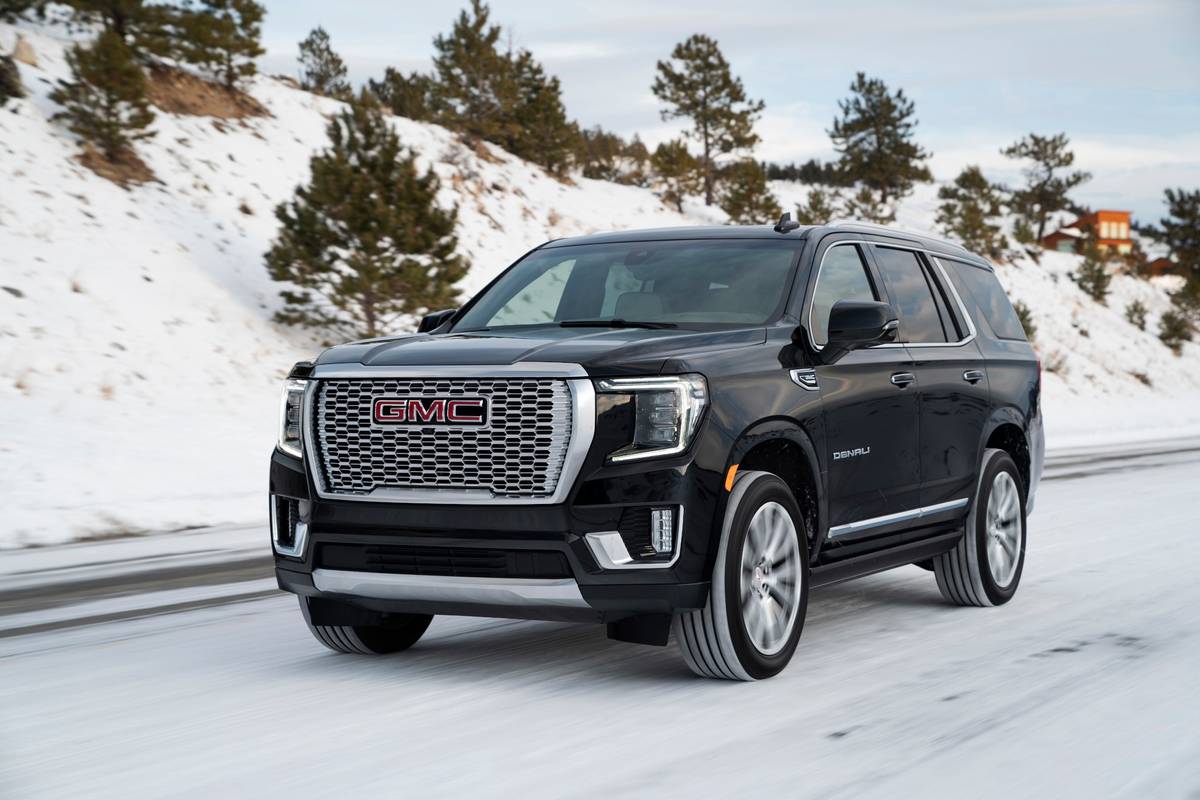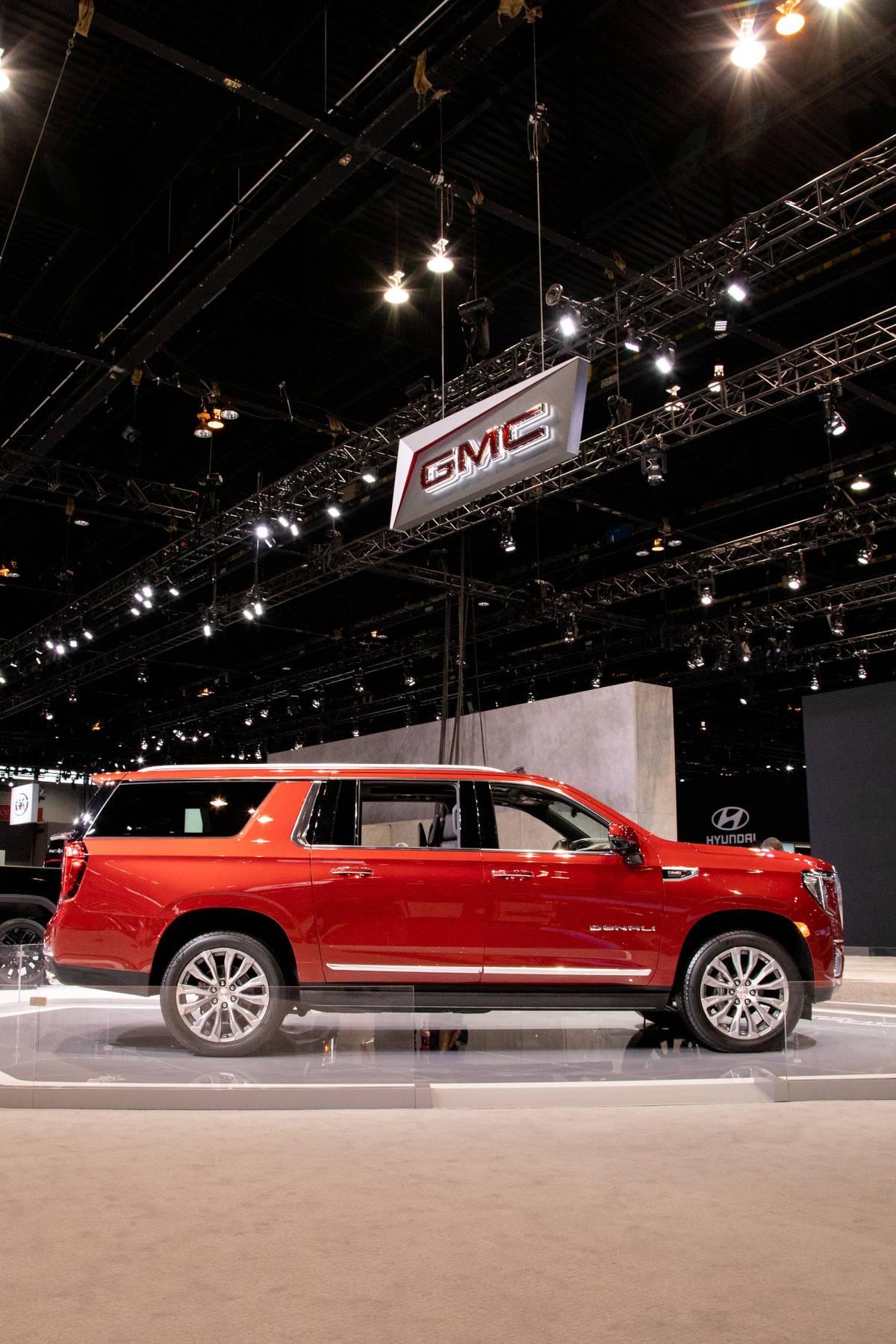Hoping the 2021 GMC Yukon Would Boast Much-Improved MPG, Towing Capacity? Sorry


GMC has announced the fuel economy, tow ratings and payload capacity for the upcoming all-new 2021 Yukon and Yukon XL lineup in anticipation of the redesigned SUVs’ arrival in showrooms later this year. The news is mixed, however: Some models saw improvement, some did not, and some saw only certain elements of fuel economy improve. It’s the same story for tow ratings. This is all a little confusing, so we’ll try and simplify things as best we can.
Related: 2021 GMC Yukon, Yukon XL: Growing in the Right Ways
The new Yukon comes with three available engines: a 5.3-liter V-8, 6.2-liter V-8 or turbo-diesel 3.0-liter inline-six-cylinder engine. We only have data for the gasoline V-8 engines right now, in both Yukon and Yukon XL guises, with rear- and four-wheel-drive.

Gas Mileage Fails to Impress
For the regular-length Yukon equipped with the 5.3-liter engine, fuel economy improved by 1 mpg in estimated city mpg for both RWD and 4WD models, but it dropped 1-2 mpg in highway ratings; in combined ratings, it ended up unchanged for the RWD and up 1 mpg for the 4WD. For the Yukon XL with the 5.3-liter V-8, it’s the same story: City mileage rose by 1 mpg for both RWD and 4WD, highway mileage dropped by 2 mpg on both models, and combined fuel economy stayed the same for the RWD and rose just 1 mpg with 4WD.
What’s extraordinary about this is that these highway mileage ratings have dropped despite the arrival of a new standard 10-speed automatic transmission, which replaces the old six-speed automatic. One would have expected better results.
- ${price_badge()}
- ${ami_badge()}
- ${battery_badge()}${ev_report_link()}
- ${hot_car_badge()}
- ${award_badge()}
- ${cpo_badge()}
${price_badge_description}
${ami_badge_description}
The EV Battery Rating is based on this vehicle's current expected range relative to the vehicles expected range when new. ${battery_badge_text}
This vehicle is certified pre-owned, backed by a manufacturer warranty, and typically undergoes a rigorous multi-point inspection to ensure quality and reliability.
This vehicle is currently in high demand given its competitive price, desirable features, and overall condition, and may have a higher chance of selling quickly.
Shop the 2021 GMC Yukon near you


It’s not any better with the big optional, upgraded 6.2-liter engine in the Yukon Denali — the only improvement to be seen comes from a 1-mpg gain in the RWD standard-length Yukon. Highway numbers dropped 1-3 mpg across the board, and the combined ratings came out mostly unchanged, except for the 4WD regular model and the RWD Yukon XL, both of which dropped by 1 mpg.
We don’t have any weight numbers for the new 2021 models, but the surprising drop in fuel economy would suggest that the new trucks might be significantly heavier than the old ones — or the aerodynamics of the new models aren’t as good as the old ones.
On the new Yukon’s fuel economy figures, GM responded to Cars.com, noting that the SUV has grown significantly and loaded up on new content, particularly the new independent rear suspension, adaptive air suspension and Magnetic Ride Control systems.
“[T]he wheelbase grew almost 5-inches which resulted in 41% more third-row legroom and a massive 66% greater cargo volume behind the third-row,” a GM spokesman stated in an email. “Customers in this segment value ride comfort, premium appointments/amenities as well as room for people and their cargo.”

Tow Ratings Fare Better (Mostly)
The Yukon’s tow ratings generally did better, with one exception. The good news first: The standard base tow rating has increased by 1,400 pounds for both RWD and 4WD versions equipped with the 5.3-liter engine, now rated at 7,900 pounds for RWD models and 7,700 for those with 4WD. The max towing package ups the RWD’s towing capacity to 8,400 pounds, which is 100 pounds less than the outgoing model; the 4WD 2021 model’s max towing capacity remains unchanged from 2020 at 8,200 pounds. If you opt for the bigger 6.2-liter engine, you’ll see your max towing capacity on 2021 models versus 2020s drop by 200 pounds on the RWD to 8,200, and 100 pounds on the 4WD to 8,000 pounds.
The towing story is a bit better on the Yukon XL, which sees its base max towing capacity bumped by 1,500 pounds in both RWD and 4WD models with the 5.3-liter V-8. The max towing numbers remain unchanged from the 2020 models with either engine.
Payload Is Maintained
One area that didn’t see any declines was the Yukon’s payload rating, which gained or held steady across the board in all versions, ranging from 2 to 102 pounds overall, model and powertrain depending. As we noted earlier, GMC hasn’t released any numbers on the new truck’s curb weight versus the current one, so we’re at a loss to explain why the Yukon has seen such a decline in its highway fuel economy and maximum towing capacity. Hopefully a drive of the new model sometime later in 2020 will provide some answers.
More From Cars.com:
- GMC Yukon News on Cars.com
- 2021 Chevrolet Suburban and Tahoe: The General Did Its Homework
- 2021 Chevrolet Suburban and Tahoe: Big Is Back
- How Do Car Seats Fit in a 2019 Chevrolet Tahoe?
- Video: 2021 GMC Yukon And Yukon XL: First Look — Cars.Com
Cars.com’s Editorial department is your source for automotive news and reviews. In line with Cars.com’s long-standing ethics policy, editors and reviewers don’t accept gifts or free trips from automakers. The Editorial department is independent of Cars.com’s advertising, sales and sponsored content departments.
Editor’s note: This story was updated May 6, 2020, to include GM’s explanation of fuel-economy changes for the 2021 Yukon and Yukon XL.

Detroit Bureau Chief Aaron Bragman has had over 25 years of experience in the auto industry as a journalist, analyst, purchasing agent and program manager. Bragman grew up around his father’s classic Triumph sports cars (which were all sold and gone when he turned 16, much to his frustration) and comes from a Detroit family where cars put food on tables as much as smiles on faces. Today, he’s a member of the Automotive Press Association and the Midwest Automotive Media Association. His pronouns are he/him, but his adjectives are fat/sassy.
Featured stories




